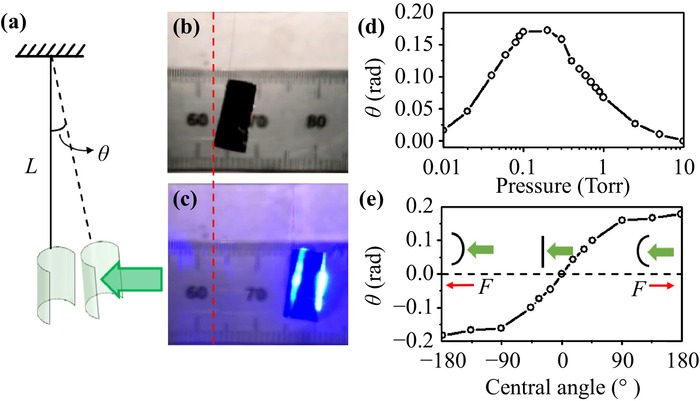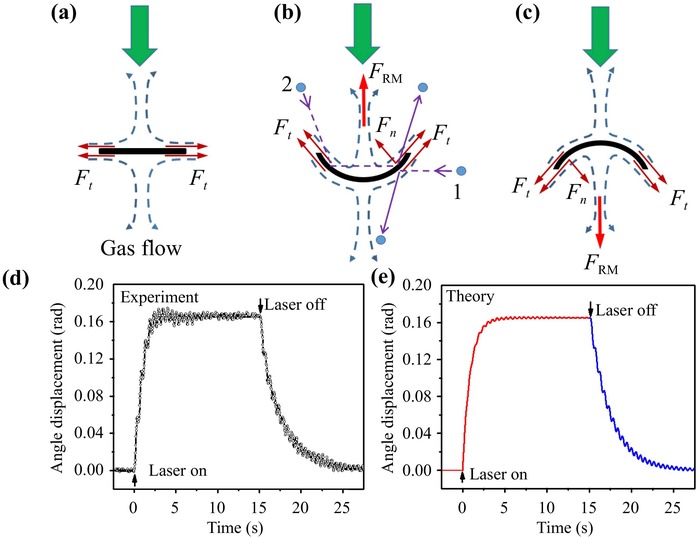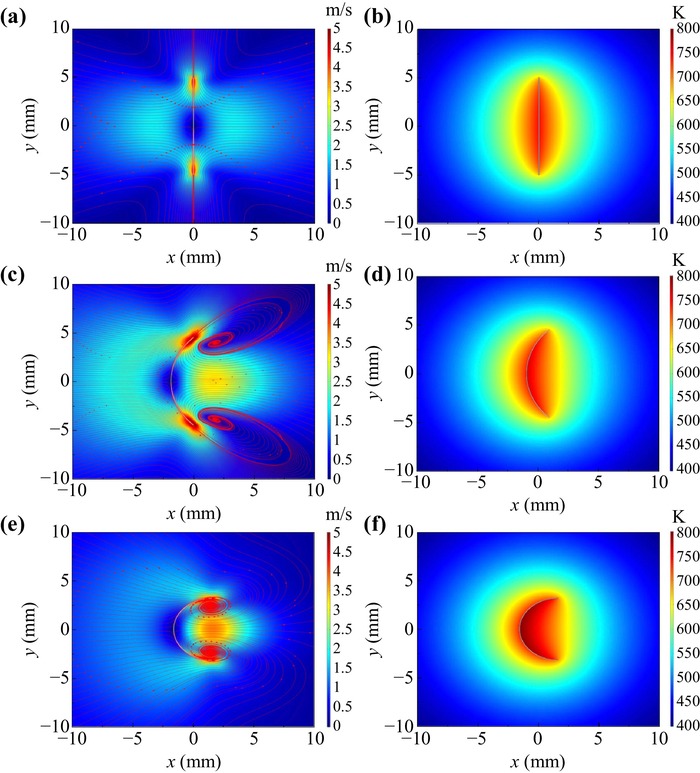 PDF(2161 KB)
PDF(2161 KB)


Optical manipulation of macroscopic curved objects
Gui-hua Chen, Mu-ying Wu, Yong-qing Li
Front. Phys. ›› 2025, Vol. 20 ›› Issue (1) : 012201.
 PDF(2161 KB)
PDF(2161 KB)
 PDF(2161 KB)
PDF(2161 KB)
Optical manipulation of macroscopic curved objects
Laser has become a powerful tool to manipulate micro-particles and atoms by radiation pressure or photophoretic force, but its effectiveness for large objects is less noticeable. Here, we report the direct observation of unusual light-induced attractive forces that allow manipulating centimeter-sized curved absorbing objects by a light beam. This force is attributed to the radiometric effect caused by the curvature of the vane and its magnitude and temporal responses are directly measured with a pendulum. Simulations suggest that the force arises from the bending of the vane, which results in a temperature difference of gas molecules between the concave and convex sides due to unbalanced gas convection. This large force (~4.4 μN) is sufficient to rotate a motor with four curved vanes at speeds up to 600 r/min and even lifting a large vane. Manipulating macroscopic objects by light could have significant applications for solar radiation-powered near-space propulsion systems and for understanding the mechanisms of negative photophoretic forces.

optical manipulation / radiometric force / geometry effect / unbalanced gas convection

Fig.1 Laser manipulation of a curved vane. (a) Schematic of the setup for pulling a curved vane with a laser beam. The light-absorbing cylindrical aluminum vane (8 mm × 8 mm in size, 15 μm in thickness) is suspended as a pendulum by an ultrafine copper wire and is pulled toward the laser beam. (b) Position of the black curved vane without laser illumination. (c) Position of the curved vane under laser illumination. (d) Angular displacement of the pendulum as a function of gas pressure. (e) Angular displacement as a function of the central angle of the vane at a pressure of 0.1 Torr. The laser power is 0.7 W at a wavelength of 450 nm. |

Fig.2 Radiometric force ( |

Fig.3 The distribution of the velocity and temperature of gas molecules near the vane on the horizontal plane bisecting the vane. (a, b) The velocity and temperature distribution of gas molecules near a flat vane. (c, d) The velocity and temperature distribution of gas molecules near a curved vane with the center angle of 90°. (e, f) The velocity and temperature distribution of gas molecules near a curved vane with the center angle of 180°. These three vanes have the same size with different degrees of bending. |

Fig.4 Crookes radiometer with four-curved vanes or black-white flat vanes. (a) When a concave absorbing aluminum surface is illuminated by a laser beam, the pulling force turns the vane towards the beam. (b) When a black-white flat paper vane is illuminated, the pushing force turns the vane away from the beam. (c‒e) Laser-induced attractive, zero, or repulsive force on a concave (c), flat-plate (d), or convex surface (e). (f) Rotation speed of Crookes radiometer with concave, flat-plate, and convex aluminum vanes with the same size (16 mm × 16 mm × 0.05 mm) verse the laser power. The pressure is 0.02 Torr. |
| [1] |
A. Ashkin, J. M. Dziedzic, and T. Yamane, Optical trapping and manipulation of single cells using infrared laser beams, Nature 330(6150), 769 (1987)
CrossRef
ADS
Google scholar
|
| [2] |
D. G. Grier, A revolution in optical manipulation, Nature 424(6950), 810 (2003)
|
| [3] |
J. Stajic, E. Hand, and J. Yeston, Manipulating ultracold matter, Science 357(6355), 984 (2017)
CrossRef
ADS
Google scholar
|
| [4] |
M. Wu, D. Ling, L. Ling, W. Li, and Y. Li, Stable optical trapping and sensitive characterization of nanostructures using standing-wave Raman tweezers, Sci. Rep. 7(1), 42930 (2017)
CrossRef
ADS
Google scholar
|
| [5] |
D. E. Smalley,E. Nygaard,K. Squire,J. Van Wagoner,J. Rasmussen,S. Gneiting,K. Qaderi,J. Goodsell,W. Rogers,M. Lindsey,K. Costner,A. Monk, M. Pearson,B. Haymore,J. Peatross, A photophoretic-trap volumetric display, Nature 553(7689), 486 (2018)
|
| [6] |
J. Lu, H. Yang, L. Zhou, Y. Yang, S. Luo, Q. Li, and M. Qiu, Light-induced pulling and pushing by the synergic effect of optical force and photophoretic force, Phys. Rev. Lett. 118(4), 043601 (2017)
CrossRef
ADS
Google scholar
|
| [7] |
O. Jovanovic, Photophoresis — Light induced motion of particles suspended in gas, J. Quant. Spectrosc. Radiat. Transf. 110(11), 889 (2009)
CrossRef
ADS
Google scholar
|
| [8] |
H. Horvath, Photophoresis — a forgotten force?, Kona 31, 181 (2014)
CrossRef
ADS
Google scholar
|
| [9] |
G. Chen, L. He, M. Wu, and Y. Li, Temporal dependence of photophoretic force optically induced on absorbing airborne particles by a power-modulated laser, Phys. Rev. Appl. 10(5), 054027 (2018)
CrossRef
ADS
arXiv
Google scholar
|
| [10] |
V. G. Shvedov, A. V. Rode, Y. V. Izdebskaya, A. S. Desyatnikov, W. Krolikowski, and Y. S. Kivshar, Giant optical manipulation, Phys. Rev. Lett. 105(11), 118103 (2010)
CrossRef
ADS
Google scholar
|
| [11] |
V. Shvedov,A. R. Davoyan,C. Hnatovsky,N. Engheta,W. Krolikowski, A long-range polarization-controlled optical tractor beam, Nat. Photonics 8(11), 846 (2014)
|
| [12] |
J. Lin, A. G. Hart, and Y. Li, Optical pulling of airborne absorbing particles and smut spores over a meter-scale distance with negative photophoretic force, Appl. Phys. Lett. 106(17), 171906 (2015)
CrossRef
ADS
Google scholar
|
| [13] |
H. Magallanes and E. Brasselet, Macroscopic direct observation of optical spin-dependent lateral forces and left-handed torques, Nat. Photonics 12(8), 461 (2018)
CrossRef
ADS
arXiv
Google scholar
|
| [14] |
D. Wolfe,A. Larraza,A. Garcia, A horizontal vane radiometer: Experiment, theory, and simulation, Phys. Fluids 28(3), 037103 (2016)
|
| [15] |
W. Crookes,XV . On attraction and repulsion resulting from radiation, Philos. Trans. R. Soc. Lond. 164, 501 (1874)
|
| [16] |
W. Crookes, On repulsion resulting from radiation. Parts III & IV, Philos. Trans. R. Soc. Lond. 166, 325 (1876)
CrossRef
ADS
Google scholar
|
| [17] |
L. H. Han, S. Wu, J. C. Condit, N. J. Kemp, T. E. Milner, M. D. Feldman, and S. Chen, Light-powered micromotor driven by geometry-assisted, asymmetric photon-heating and subsequent gas convection, Appl. Phys. Lett. 96(21), 213509 (2010)
CrossRef
ADS
Google scholar
|
| [18] |
A. Ketsdever, N. Gimelshein, S. Gimelshein, and N. Selden, Radiometric phenomena: From the 19th to the 21st century, Vacuum 86(11), 1644 (2012)
CrossRef
ADS
Google scholar
|
| [19] |
M. Azadi, G. A. Popov, Z. Lu, A. G. Eskenazi, A. J. W. Bang, M. F. Campbell, H. Hu, and I. Bargatin, Controlled levitation of nanostructured thin films for sun-powered near-space flight, Sci. Adv. 7(7), eabe1127 (2021)
CrossRef
ADS
arXiv
Google scholar
|
| [20] |
J. C. Maxwell, VII. On stresses in rarified gases arising from inequalities of temperature, Philos. Trans. R. Soc. Lond. 170, 231 (1879)
|
| [21] |
O. Reynolds, XVIII. On certain dimensional properties of matter in the gaseous state, Philos. Trans. R. Soc. Lond. 170, 727 (1879)
|
| [22] |
A. Einstein, Zur Theorie der Radiometrerkrafte, Eur. Phys. J. A 27(1), 1 (1924)
CrossRef
ADS
Google scholar
|
| [23] |
G. W. Evan, Radiometers with curved vanes, Science ns-2(29), 215 (1883)
CrossRef
ADS
Google scholar
|
| [24] |
A. D. Strongrich, W. J. O’Neill, A. G. Cofer, and A. A. Alexeenko, Experimental measurements and numerical simulations of the Knudsen force on a non-uniformly heated beam, Vacuum 109, 405 (2014)
CrossRef
ADS
Google scholar
|
| [25] |
A. Ventura, N. Gimelshein, S. Gimelshein, and A. Ketsdever, Effect of vane thickness on radiometric force, J. Fluid Mech. 735, 684 (2013)
CrossRef
ADS
Google scholar
|
| [26] |
A. Passian, R. J. Warmack, T. L. Ferrell, and T. Thundat, Thermal transpiration at the microscale: a Crookes cantilever, Phys. Rev. Lett. 90(12), 124503 (2003)
CrossRef
ADS
Google scholar
|
| [27] |
T. Zhu, W. Ye, and J. Zhang, Negative Knudsen force on heated microbeams, Phys. Rev. E 84(5), 056316 (2011)
CrossRef
ADS
Google scholar
|
| [28] |
B. M. Cornella, A. D. Ketsdever, N. E. Gimelshein, and S. F. Gimelshein, Analysis of multivane radiometer arrays in high-altitude propulsion, J. Propuls. Power 28(4), 831 (2012)
CrossRef
ADS
Google scholar
|
| [29] |
M. Young,S. Keith,A. Pancotti, An overview of advanced concepts for near space systems, in: 45th AIAA/ASME/SAE/ASEE Joint Propulsion Conference & Exhibit, American Institute of Aeronautics and Astronautics, 2009
|
| [30] |
I. Levchenko, K. Bazaka, S. Mazouffre, and S. Xu, Prospects and physical mechanisms for photonic space propulsion, Nat. Photonics 12(11), 649 (2018)
CrossRef
ADS
Google scholar
|
| [31] |
R. W. Bosworth and A. D. Ketsdever, Determination of the effect of particle thermal conductivity on thermophoretic force, AIP Conf. Proc. 1786, 060003 (2016)
CrossRef
ADS
Google scholar
|
| [32] |
S. Taguchi and K. Aoki, Motion of an array of plates in a rarefied gas caused by radiometric force, Phys. Rev. E 91(6), 063007 (2015)
CrossRef
ADS
Google scholar
|
| [33] |
T. Baier, S. Hardt, V. Shahabi, and E. Roohi, Knudsen pump inspired by Crookes radiometer with a specular wall, Phys. Rev. Fluids 2(3), 033401 (2017)
CrossRef
ADS
arXiv
Google scholar
|
| [34] |
The simulation was carried out on the Tianhe-2 supercomputer system of the National Supercomputing Center in Guangzhou.
|
| [35] |
M. Scandurra, F. Iacopetti, and P. Colona, Gas kinetic forces on thin plates in the presence of thermal gradients, Phys. Rev. E 75(2), 026308 (2007)
CrossRef
ADS
Google scholar
|
 PDF(2161 KB)
PDF(2161 KB)
Supplementary files
fop-25008-of-chenguihua_suppl_1 (1645 KB)
See also:
From century-long studies to emerging frontiers: The power of light forceChuji Wang
Frontiers of Physics. 2025, Vol.20(1): 012204
 Fig.1 Laser manipulation of a curved vane. (a) Schematic of the setup for pulling a curved vane with a laser beam. The light-absorbing cylindrical aluminum vane (8 mm × 8 mm in size, 15 μm in thickness) is suspended as a pendulum by an ultrafine copper wire and is pulled toward the laser beam. (b) Position of the black curved vane without laser illumination. (c) Position of the curved vane under laser illumination. (d) Angular displacement of the pendulum as a function of gas pressure. (e) Angular displacement as a function of the central angle of the vane at a pressure of 0.1 Torr. The laser power is 0.7 W at a wavelength of 450 nm.
Fig.1 Laser manipulation of a curved vane. (a) Schematic of the setup for pulling a curved vane with a laser beam. The light-absorbing cylindrical aluminum vane (8 mm × 8 mm in size, 15 μm in thickness) is suspended as a pendulum by an ultrafine copper wire and is pulled toward the laser beam. (b) Position of the black curved vane without laser illumination. (c) Position of the curved vane under laser illumination. (d) Angular displacement of the pendulum as a function of gas pressure. (e) Angular displacement as a function of the central angle of the vane at a pressure of 0.1 Torr. The laser power is 0.7 W at a wavelength of 450 nm. Fig.2 Radiometric force (F R M) on a heated curved vane due to molecular collisions. (a) Schematic showing tangential shear forces (F t) on the surface of a hot flat vane caused by gas flow. The net F R M on the flat vane is zero due to geometric balance. (b) Normal pressure force (F n) and shear force on a surface element of a concave vane, with the total F RM pointing in the upward direction. Molecules incident on the convex side experience single collisions, while molecules incident on the concave side undergo multiple collisions. (c) F RM acting on a convex vane. (d) Experimental angular displacement versus time of a pendulum (with an 8 mm × 8 mm cylindrical vane) when a 1 W laser beam is turned on or off at a pressure of 0.1 Torr. (e) Theoretical modeling of the dynamic angular displacement of the pendulum, with rise time τ r = 0.9 s, fall time τ f = 2.4 s, damping coefficient β = 0.12 s−1, and pendulum length L = 70 mm.
Fig.2 Radiometric force (F R M) on a heated curved vane due to molecular collisions. (a) Schematic showing tangential shear forces (F t) on the surface of a hot flat vane caused by gas flow. The net F R M on the flat vane is zero due to geometric balance. (b) Normal pressure force (F n) and shear force on a surface element of a concave vane, with the total F RM pointing in the upward direction. Molecules incident on the convex side experience single collisions, while molecules incident on the concave side undergo multiple collisions. (c) F RM acting on a convex vane. (d) Experimental angular displacement versus time of a pendulum (with an 8 mm × 8 mm cylindrical vane) when a 1 W laser beam is turned on or off at a pressure of 0.1 Torr. (e) Theoretical modeling of the dynamic angular displacement of the pendulum, with rise time τ r = 0.9 s, fall time τ f = 2.4 s, damping coefficient β = 0.12 s−1, and pendulum length L = 70 mm. Fig.3 The distribution of the velocity and temperature of gas molecules near the vane on the horizontal plane bisecting the vane. (a, b) The velocity and temperature distribution of gas molecules near a flat vane. (c, d) The velocity and temperature distribution of gas molecules near a curved vane with the center angle of 90°. (e, f) The velocity and temperature distribution of gas molecules near a curved vane with the center angle of 180°. These three vanes have the same size with different degrees of bending.
Fig.3 The distribution of the velocity and temperature of gas molecules near the vane on the horizontal plane bisecting the vane. (a, b) The velocity and temperature distribution of gas molecules near a flat vane. (c, d) The velocity and temperature distribution of gas molecules near a curved vane with the center angle of 90°. (e, f) The velocity and temperature distribution of gas molecules near a curved vane with the center angle of 180°. These three vanes have the same size with different degrees of bending. Fig.4 Crookes radiometer with four-curved vanes or black-white flat vanes. (a) When a concave absorbing aluminum surface is illuminated by a laser beam, the pulling force turns the vane towards the beam. (b) When a black-white flat paper vane is illuminated, the pushing force turns the vane away from the beam. (c‒e) Laser-induced attractive, zero, or repulsive force on a concave (c), flat-plate (d), or convex surface (e). (f) Rotation speed of Crookes radiometer with concave, flat-plate, and convex aluminum vanes with the same size (16 mm × 16 mm × 0.05 mm) verse the laser power. The pressure is 0.02 Torr.
Fig.4 Crookes radiometer with four-curved vanes or black-white flat vanes. (a) When a concave absorbing aluminum surface is illuminated by a laser beam, the pulling force turns the vane towards the beam. (b) When a black-white flat paper vane is illuminated, the pushing force turns the vane away from the beam. (c‒e) Laser-induced attractive, zero, or repulsive force on a concave (c), flat-plate (d), or convex surface (e). (f) Rotation speed of Crookes radiometer with concave, flat-plate, and convex aluminum vanes with the same size (16 mm × 16 mm × 0.05 mm) verse the laser power. The pressure is 0.02 Torr./
| 〈 |
|
〉 |